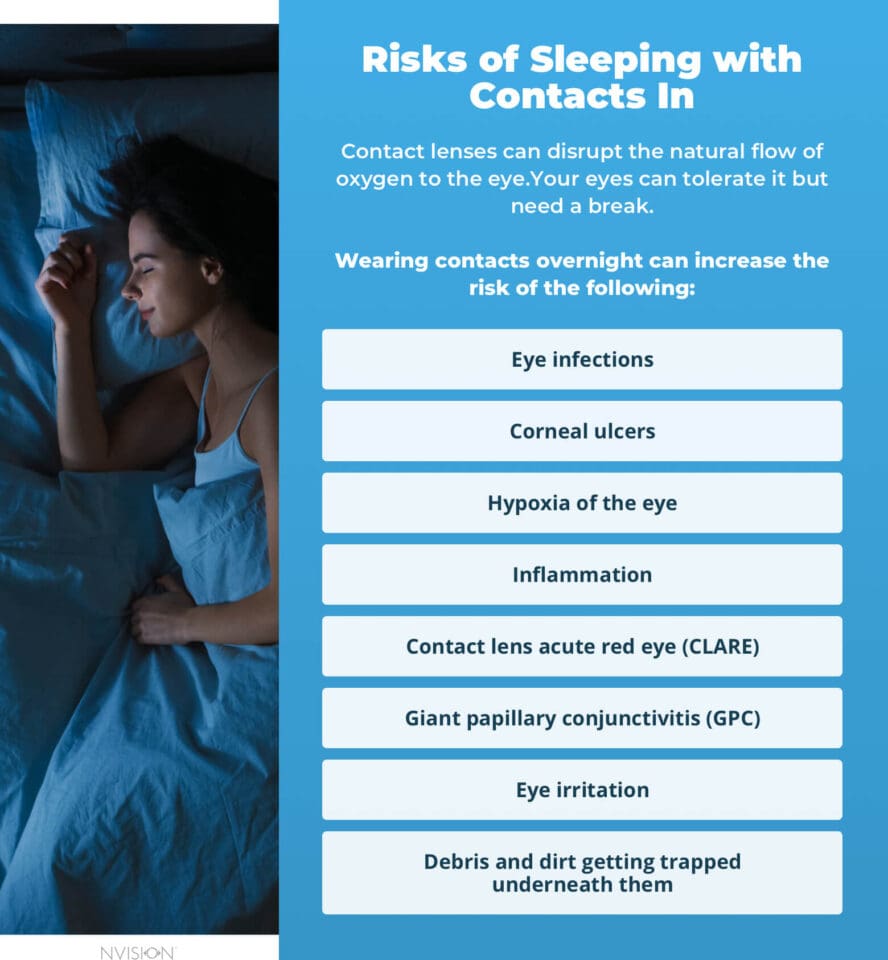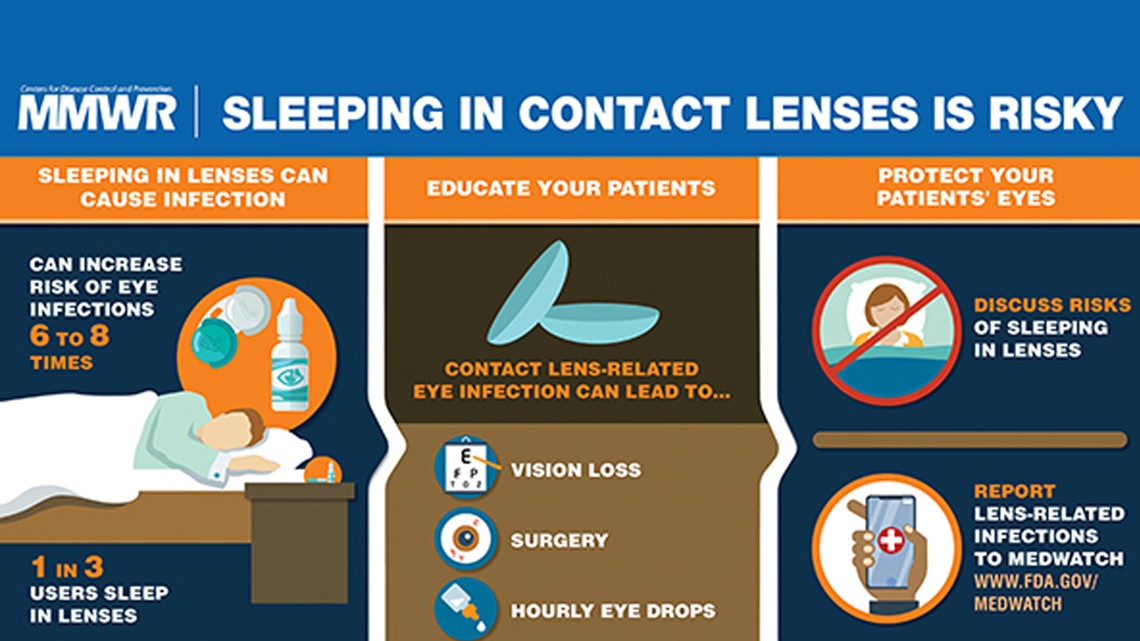Contact Lens Risks: Why Sleeping In Them Is A Bad Idea!
Ever drifted off for a quick nap, only to wake up with gritty, irritated eyes? If you wear contact lenses, that innocent snooze could be doing more harm than you think. The absolute truth is: napping or sleeping in contact lenses regardless of the brand or type significantly elevates your risk of serious eye infections and discomfort.
It's a surprisingly common habit. Many contact lens wearers, especially teenagers and young adults, are guilty of occasionally dozing off with their lenses in. Perhaps you're exhausted after a long day, or maybe you just didn't bother to remove them before settling down for a "quick" rest. However, even a short nap with contacts can create a breeding ground for bacteria and deprive your cornea of the oxygen it desperately needs.
| Category | Information |
|---|---|
| Name | Allison Babiuch, MD |
| Profession | Ophthalmologist |
| Specialty | Corneal Health, Contact Lens-Related Complications |
| Education | Medical Degree: [Insert University Name Here]Residency: [Insert Hospital Name Here]Fellowship: [Insert Subspecialty and Institution if applicable] |
| Areas of Expertise | Dry Eye, Corneal Ulcers, Contact Lens Infections, General Ophthalmology |
| Professional Affiliations | [List any professional organizations, e.g., American Academy of Ophthalmology] |
| Website/Profile | American Academy of Ophthalmology |
Allison Babiuch, MD, a leading ophthalmologist, emphasizes the dangers of sleeping in contacts. "When you sleep in contact lenses, the front surface of the eye, known as the cornea, becomes deprived of oxygen, and the risk of corneal infection increases," she explains. This oxygen deprivation makes your eyes more susceptible to dryness, irritation, and a host of potential infections. Think of it this way: your cornea is like a plant, and oxygen is its water. Without that vital supply, it wilts and becomes vulnerable.
- Leo Virgo Cusp Are You One Traits Compatibility More
- The Untold Story Of Band Of Brothers Captain Sobel Fact Vs Fiction
Studies have consistently demonstrated a strong link between sleeping in contact lenses and a significantly higher risk of eye infections. Some research suggests that the risk of infection can increase by up to 800% when you snooze with your lenses in. This isn't just a minor irritation; we're talking about potentially serious complications that could threaten your vision. Your poor, hardworking cornea is already striving to mend itself, and all of a sudden, bacteria move in and begin to colonize, leading to serious health issues.
So, what exactly are these potential risks? Microbial keratitis, a severe infection of the cornea, is a primary concern. But the dangers don't stop there. Sleeping in contacts can also lead to corneal ulcers, painful open sores on the cornea that can cause scarring and vision loss. Conjunctivitis, commonly known as pink eye, is another possible consequence, characterized by redness, itching, and discharge. And finally, corneal hypoxia, a condition where the cornea doesn't receive enough oxygen, can result in blurred vision and discomfort. Its definitely a situation that one would want to avoid, and that begins by being aware of the harm that one causes the eyes by wearing lenses through the night.
The golden rule is simple: always remove your contact lenses before napping or going to sleep. This applies to all types of contact lenses, unless specifically prescribed otherwise by your eye care professional. Even if you're only planning on a short catnap, taking the extra few seconds to remove your lenses can save you a lot of pain and potential long-term damage. If you feel there's a risk you will fall asleep, take the lenses out before you even lie down.
- Meet Courtney Taylor Olsen Facts About The Olsen Familys Hidden Sister
- Shailene Woodley From Teen Star To Activist Icon Beyond
Establishing a consistent routine for removing your contact lenses is crucial. Make it a habit to take them out at the same time every night, before you even begin to wind down for bed. Use alarms or reminders on your phone to jog your memory if you're prone to forgetting. Keep your contact lens case and solution readily accessible so that removing your lenses becomes a seamless part of your nightly ritual.
Proper contact lens care is equally important. When you remove your lenses, always store them in an approved disinfection solution or system. Never, ever use saliva to rinse your contact lenses. Saliva is teeming with bacteria that can wreak havoc on your eyes. Always use fresh, sterile contact lens solution. Regular cleaning and disinfecting will help eliminate harmful microorganisms and keep your lenses clean and comfortable.
While modern soft contact lenses boast advanced technology to ensure adequate oxygen permeability during daily wear, closing your eyes during sleep significantly restricts oxygen flow to the cornea. When you wear contact lenses, particularly while sleeping, you essentially cut off this crucial oxygen supply. Remember, your cornea relies on atmospheric oxygen to stay healthy. By depriving it of this vital resource, you create an environment conducive to infection and other complications.
Of course, accidents happen. Perhaps you unexpectedly dozed off on the couch or fell asleep on a long flight. If you wake up with your contact lenses still in, don't panic. First, carefully remove your lenses and discard the solution from the lens case. Then, observe your eyes for any signs of irritation, redness, or pain. If you experience any of these symptoms, or if you have any concerns, contact your eye care professional immediately.
Beyond the risks associated with sleeping in contact lenses, it's also important to consider the impact of naps on your overall sleep health. While short naps can be beneficial for boosting alertness and improving performance, frequent or prolonged napping could indicate underlying sleep problems. Dr. Wells suggests that, "If you need a nap every day, that could indicate a deficit in sleep quality, sleep quantity, or sleep timing." If you find yourself relying on naps regularly, it's worth exploring strategies to improve your nighttime sleep quality and quantity. Consider seeking professional help to diagnose and address any potential sleep disorders.
Now, let's consider the different types of contact lenses and their suitability for overnight wear. Daily wear contact lenses are designed to be worn during the day and removed at night. They require daily cleaning and disinfection and are never intended for overnight use. Sleeping in daily wear lenses poses a significant risk of eye infections. On the other hand, extended wear contact lenses are specifically approved for overnight wear. Depending on the brand, they can be worn continuously for up to 30 days. However, even with extended wear lenses, it's crucial to follow your eye care professional's recommendations and remove them periodically for cleaning and disinfection to minimize the risk of complications.
When it comes to choosing contact lenses, daily disposables offer several advantages. Since you discard them after each use, there's a lower risk of bacterial contamination and infection compared to reusable lenses. Additionally, daily disposables may be more cost-effective in the long run, as they eliminate the need for cleaning and storage solutions. Ultimately, the best type of contact lens for you will depend on your individual needs and lifestyle. Consult with your eye care professional to determine the most appropriate option.
While the focus has been largely on the dangers of sleeping in contacts, there are alternative perspectives on napping that warrant consideration. "Contact napping," for instance, refers to a practice where parents maintain physical contact with their baby while the baby naps. This approach can foster bonding and provide reassurance to both parent and child. However, it's essential to prioritize safety and ensure that the parent remains alert and responsive throughout the nap. Contact naps are not for everyone, and the decision to engage in this practice should be based on individual circumstances and preferences. As Bruno states, "I can't tell you if contact naps are good or bad...that's something the individual who's primarily doing the contact naps gets to decide."
There's also the concept of "replacement naps," which are taken to compensate for previous sleep loss. These naps should be long enough to allow for a complete sleep cycle, typically around 90 minutes. A 90-minute nap can help restore energy levels and improve cognitive function. However, it's crucial to avoid napping too close to bedtime, as this can disrupt your nighttime sleep. The aim is to use naps strategically to address sleep deprivation, rather than relying on them as a substitute for adequate nighttime sleep.
In conclusion, while the occasional accidental nap in your contacts may not cause immediate harm, it's crucial to prioritize safe contact lens practices. The general rule of thumb remains: remove your lenses before napping or sleeping. This simple step can significantly reduce your risk of eye infections and other complications. Establish a consistent removal routine, practice proper lens care, and consult with your eye care professional to ensure the health and comfort of your eyes. Remember, healthy eyes are essential for clear vision and overall well-being.
- Bumpy Johnson The Real Story Behind Harlems Godfather
- Claudia Heffner Peltz Model Wife Philanthropist Full Story

Is It Actually Dangerous to Sleep With Contacts In? NVISION

I was embarrassed to admit I sleep in my contacts; why you should stop

Can You Sleep with Contacts In? Warby Parker